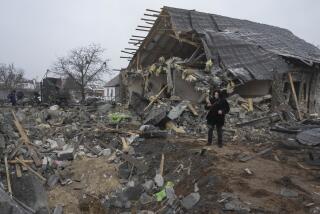Russia Pumps $295 Million Into Banking System as Crisis Strikes : Currency: Sustained drop in inflation and shored-up ruble have left many banks insolvent. Major shakeout is expected.
- Share via
MOSCOW — Russia’s commercial banking system, a dynamic but shaky pillar of the post-Soviet economy, has been paralyzed by its first insolvency crisis, prompting the government Friday to commit nearly $300 million to revive it.
Officials said they had avoided a systemwide collapse but still face the politically risky task of forcing a shakeout that could close as many as 100 banks, along with enterprises they have kept afloat with unsound loans.
The crisis is one inevitable downside of a long-awaited achievement by free-market advocates in President Boris N. Yeltsin’s government: the sustained drop in Russia’s inflation rate and the shoring up of the ruble.
In the high-inflation climate of recent years, banks were able to augment unpredictable cash flows from risky loans to unsound Russian businesses by engaging in currency speculation. Many of Russia’s 3,000 or so banks are little more than currency-exchange houses.
Banks most dependent on currency trading suffered as inflation dropped steadily, from 18% in January to 5.4% last month. They got more bad news on July 5, when the government set a narrow, fixed range for the ruble’s value against the dollar and vowed to maintain it until Oct. 1.
On Thursday, First Deputy Prime Minister Anatoly B. Chubais extended the narrow currency trading band through the end of this year, declaring: “It is much more difficult for banks to make money, to make profits. . . . Banks have to change their attitude, cut their cost, look for real projects.”
The banking crisis came after a week of reports in the Russian media that at least nine banks, including two of the biggest, had failed to pay back debts in overnight inter-bank trading. The newspaper Izvestia put the total of unmet inter-bank obligations at $339 million.
Uncertain which banks were solid enough to trust, Russian bankers halted all lending to each other on what has come to be known here as Black Thursday.
As the banking system remained closed Friday, the government moved to shore it up temporarily by offering $68 million in seven-day loans to banks and buying $227 million in treasury bills from them.
“By the middle of the day the situation was resolved. Banks have sufficient funds,” Chubais said Friday. But he added that the crisis was “a signal of a rather serious problem” and warned, “No country going through economic stabilization has been able to avoid difficulties in the banking sector.”
Chubais said an official panel will propose a “restructuring” of the banking system. Tatyana Paramonova, the central bank chairwoman, said only those banks judged capable of repaying will be eligible for the $68 million in state credits. As many as 100 banks may lose their licenses, she said.
“The crisis is not over yet, it is only suspended,” said Mikhail Berger, an economic commentator for Izvestia. “The leading bankers . . . are in genuine panic and hysteria. These are not small banks. These are banks of the first dozen.”
Russian newspapers reported that Inkombank, Russia’s second-largest commercial bank, and Menatep, the seventh-largest, had failed to meet inter-bank payments. Although neither bank would confirm those reports, Inkombank did withdraw recently from a consortium to buy shares in government enterprises, raising doubts about its health.
Some bankers complained that the government provoked the crisis by moving too zealously to stabilize the ruble.
“The economy needs more money for payments,” Sergei Balagansky, chief analyst of Stolichny Bank, told Reuters. “They have tried to cut inflation too fast. It is like stopping a car. If you brake too fast, it leaves the road.”
It remains to be seen how far the government will allow the economy to be squeezed before the Dec. 17 parliamentary elections. With unemployment officially reported at 7.7% and rising quickly, economic reformers in the government are certain to face political pressure to dole out subsidies and avoid new bankruptcies.
Prime Minister Viktor S. Chernomyrdin’s Kremlin-backed party, called Our Home Is Russia, has adopted a campaign message that only the current authorities can guarantee stability. Officials do seem to have learned a lesson last Oct. 11, a day remembered as Black Tuesday, when an outpouring of inflationary subsidies triggered the worst post-Soviet slide of the ruble’s value.
Part of Chernomyrdin’s campaign strategy was Thursday’s decision to extend the currency trading range, which keeps the ruble valued at between 4,300 and 4,900 to the dollar, until after the election.
But economists say the central bank’s foreign exchange reserves, which have doubled to $12.4 billion this year as Russian flight capital returns home, are comfortable enough to sustain both the ruble and a mild increase in inflationary subsidies, if the government finds them politically useful. Chubais noted that Friday’s emergency credits to the banks are only a tiny fraction of the reserves.
More to Read
Sign up for Essential California
The most important California stories and recommendations in your inbox every morning.
You may occasionally receive promotional content from the Los Angeles Times.













